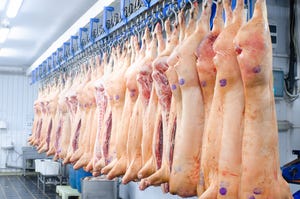FSIS declares Salmonella an adulterant in some chicken products
National Chicken Council says new regulation will cost jobs, increase food waste.
April 26, 2024

The U.S. Department of Agriculture’s Food Safety and Inspection Service has announced its final determination to declare Salmonella an adulterant in raw breaded stuffed chicken products when they exceed a specific threshold (1 colony forming unit per gram or higher) for Salmonella contamination.
This final determination is part of FSIS’ broader efforts to reduce Salmonella illnesses associated with the raw poultry supply in the United States. FSIS intends to address Salmonella contamination in other raw poultry products later this year.
“Under President Biden’s leadership, USDA is taking significant steps toward keeping American consumers safe from foodborne illness,” said Agriculture Secretary Tom Vilsack. “This final determination marks the first time that Salmonella is being declared an adulterant in a class of raw poultry products. This policy change is important because it will allow us to stop the sale of these products when we find levels of Salmonella contamination that could make people sick.”
Under this determination, FSIS will consider to be adulterated any raw breaded stuffed chicken products that include a chicken component that tested positive for Salmonella at 1 CFU per gram or higher.
New Salmonella regulation sets dangerous precedent
The National Chicken Council points out not ready-to-eat frozen, raw, breaded, stuffed chicken products would include products like chicken cordon bleu and chicken kiev. They are typically sold raw, labeled to indicate their raw nature, and must be cooked properly following the instructions on the package.
“NCC is gravely concerned that the precedent set by this abrupt shift in longstanding policy has the potential to shutter processing plants, cost jobs, and take safe food and convenient products off shelves. We’re also surprised by FSIS’s victory lap here when the agency has no idea if this will move the needle on public health,” said NCC President Mike Brown in response.
NCC estimates that on an annual basis, over 200 million servings of this product will be lost, 500-1000 people will lose their jobs, and the annual cost to industry is significantly higher than USDA’s estimates. The trade association says it is likely that this proposal would drive smaller producers of this product out of business entirely.
“USDA has devoted untold amounts of time, effort and taxpayer dollars – and is willing to drive up grocery store prices for consumers and impose millions of dollars of costs on American businesses – all to develop a policy intended to reduce foodborne illness outbreaks for a product that hasn’t even been associated with an outbreak in three years and that has been associated with only one outbreak in the past nine years,” Brown continued.
“NCC strongly supports effective public health measures and science-driven policy. USDA’s determination is neither.
“What has been shown to be effective is clear and effective labeling, robust process controls and attention to raw material sourcing. NCC members have implemented these and other best practices, and NCC has repeatedly asked USDA to make many of these best practices mandatory, with no response.
“There is no silver bullet or one-size-fits all approach to food safety, which is why we employ a multi-hurdle strategy. The only way to ensure our food is safe 100 percent of the time is by following science-based procedures when raising and processing chicken, and by handling and cooking it properly at home.
“NCC remains confident these products can be prepared and consumed safely, and NCC member companies will continue to work day in and day out to implement sound, science-based food safety programs that will continue to make America’s most popular protein even safer,” Brown concluded.
Outbreak investigations
FSIS says it plans to carry out verification procedures, including sampling and testing of the raw incoming chicken component of these products prior to stuffing and breading, to ensure producing establishments control Salmonella in these products. If the chicken component in these products does not meet this standard, the product lot represented by the sampled component would not be permitted to be used to produce the final raw breaded stuffed chicken products. The determination, including FSIS’ sampling and verification testing, will be effective 12 months after its publication in the Federal Register.
In determining that Salmonella is an adulterant in raw breaded stuffed chicken products, FSIS says it considered the best available science and data using similar criteria as in its 1994, 1999 and 2011 E. coli policymaking. When FSIS declared seven Shiga toxin-producing Escherichia coli (STEC) strains to be adulterants in select raw beef products, it relied on several factors, including the available information on serotypes linked to human illnesses, infectious dose, severity of illnesses and typical consumer preparation practices associated with a product. The breaded stuffed chicken products determination relied on the same factors.
FSIS and its public health partners have investigated 14 Salmonella outbreaks and approximately 200 illnesses associated with these products since 1998. The most recent outbreak was in 2021 and resulted in illnesses across 11 states. These products account for less than 0.15% of the total domestic chicken supply, but outbreaks linked to these products represented approximately 5% of all chicken-associated outbreaks in the U.S. during 1998-2020.
Raw breaded stuffed chicken products are pre-browned and may appear cooked, but the chicken is raw. The products are typically cooked by consumers from a frozen state, which increases the risk of the product not reaching the internal temperature needed to destroy Salmonella. Despite FSIS’ and industry’s efforts to improve labeling, these products continue to be associated with Salmonella illness outbreaks.
The Centers for Disease Control and Prevention estimates that Salmonella bacteria cause over 1 million human infections in the U.S. each year. Food is the leading source of Salmonella infections and poultry products are one of the leading sources of foodborne Salmonella illnesses.
FSIS will continue to evaluate and, if necessary, refine its policies and standards related to the oversight of raw breaded stuffed chicken products as advances in science and technology related to pathogen levels, serotypes, laboratory methods and infectious dose become available.
FSIS says the final determination builds on USDA’s continued efforts under the Biden-Harris Administration to protect American consumers, whether to ensure food safety or prevent false and misleading label claims. Earlier this year, USDA published a final rule allowing the voluntary “Product of USA” claim to be applied only to those FSIS-regulated products that are derived from animals born, raised, slaughtered and processed in the United States. USDA is currently re-evaluating the FSIS guideline for animal-raising claims to better ensure that they are adequately substantiated.
About the Author(s)
You May Also Like


.png?width=300&auto=webp&quality=80&disable=upscale)
